Jennings vintage analogue synth by Rhythmic Robot is a meticulously faithful recreation of one of the very first synthesisers, the valve-based Jennings Univox.
The Univox was designed in 1946 by Derek Underdown and Tom Jennings, who went on to create Vox amplifiers and define the guitar sound of a generation.
Jennings excels at exceptional string and organ sounds. Producers looking for unique valve synthesiser sounds from a long-gone era should love it
$26.25 $35.00
Welcome to a sound from 1946. A sound that once echoed around The Cavern in Liverpool, coaxed into life by the fingers (and knees…) of the Beatles. A sound that in 1962 defined a number 1 chart topper with no words – the world’s first synth-pop hit. A sound designed by a music technology legend, but which has been sleeping, forgotten, lost in the mists of time… until now…
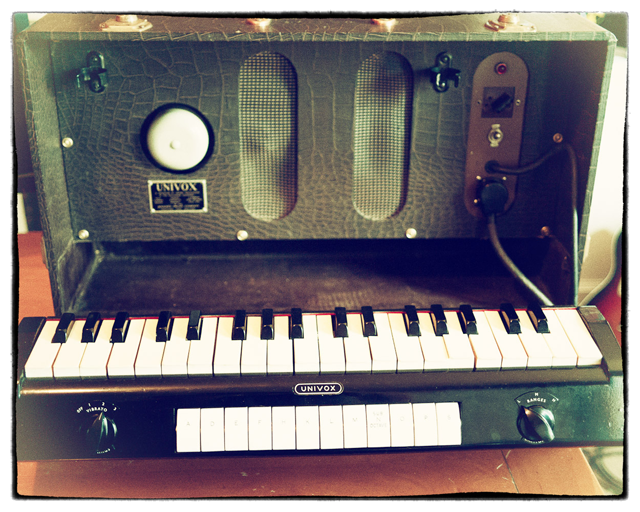 Jennings is a meticulously faithful recreation of one of the very first synthesisers, the valve-based Jennings Univox. The Univox was designed in 1946 by Derek Underdown and Tom Jennings, who went on to create Vox amplifiers and define the guitar sound of a generation. It was manufactured in the 50s and 60s along the same lines as its contemporary, the Clavioline, as a gigging keyboard for bands to use to supplement the basic acoustic piano that most pubs and clubs offered. To this end it was designed with portability in mind: it had its own onboard amplification, and packed into its own suitcase for transport, while the keyboard portion of the synth was detachable and designed to fit just under and in front of a piano keyboard.
Jennings is a meticulously faithful recreation of one of the very first synthesisers, the valve-based Jennings Univox. The Univox was designed in 1946 by Derek Underdown and Tom Jennings, who went on to create Vox amplifiers and define the guitar sound of a generation. It was manufactured in the 50s and 60s along the same lines as its contemporary, the Clavioline, as a gigging keyboard for bands to use to supplement the basic acoustic piano that most pubs and clubs offered. To this end it was designed with portability in mind: it had its own onboard amplification, and packed into its own suitcase for transport, while the keyboard portion of the synth was detachable and designed to fit just under and in front of a piano keyboard.
It generated a rich, warm, analogue wave (more or less a sawtooth) which could be processed, adjusted and filtered using 12 “tabs” along the front of the keyboard. These were not simply organ stops; they altered the base waveform rather than adding to it (with the exception of Tab N, “Sub Osc”, which does add a sub-oscillator). Some tabs engaged filters or tilt-EQs; some clipped the waveform or otherwise distorted it; some added or enhanced a percussive transient peak for greater definition. Using different combinations of these tabs, over 2000 different voicings could be created (before factoring in vibrato settings!), while a knee-lever controlled the output volume on the fly for a surprisingly expressive playing experience.
Vibrato (three speeds, two depths) added movement to the sound, while a transpose knob allowed the three-octave keyboard to access five octaves of range. The Univox’s own speaker cabinet contributed greatly to its tone, and the sound could be varied between sweet and singing and raw and raucous with the flick of a couple of tabs and the twist of a dial.
The Univox found its way into some of the Beatles’ early sessions when they were playing in the Cavern in Liverpool, and it is almost certainly the sound of the 1962 synth-pop number 1 “Telstar” by the Tornadoes (there’s some dispute as to whether the Univox or the Clavioline can take this accolade, but we’re 90% certain it’s the Jennings. The most significant difference between the Clavioline and the Univox was that the Clavioline’s base wave was a kind-of square wave, while the Univox’s was a kind-of sawtooth; which gives the Univox its unique – and, we think, warmer – tone.)
What’s beyond doubt is that the Jennings Univox was one of the very first pioneers of synthesis, combining the valve tone-creation circuitry that had marked out earlier classics like the Hammond Novachord with a far more portable, band-friendly form factor and the instant satisfaction of its tab switch tone controls.
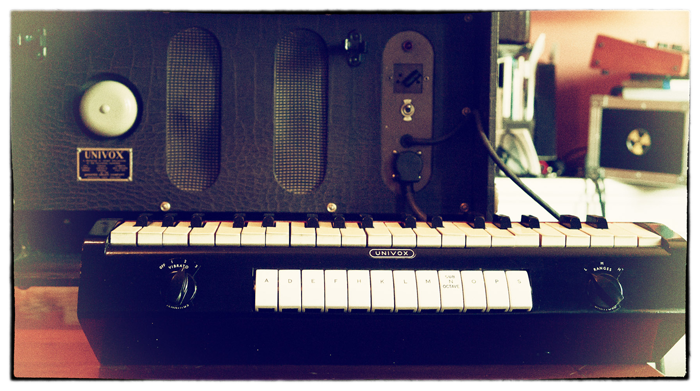 We found our Univox at an auction, and were instantly entranced by it. Everything from the crocodile-skin case to the thick, heavy rubber cables carrying lethal voltages back and forth between the keyboard and the cabinet just made us fall in love. The enormous Bakelite chicken-head knobs; the little glowing power lamp; the toggle switches; and that rack of inscrutable tabs (A? D? F? H? What did they mean? What had happened to B, C, E and G? If you really want to know the answers to these key questions, visit Creating Jennings.) Anyway, it was all just too wonderful to pass up. So we bought it like a shot, and have spent the past several months meticulously and exhaustively recreating it in software.
We found our Univox at an auction, and were instantly entranced by it. Everything from the crocodile-skin case to the thick, heavy rubber cables carrying lethal voltages back and forth between the keyboard and the cabinet just made us fall in love. The enormous Bakelite chicken-head knobs; the little glowing power lamp; the toggle switches; and that rack of inscrutable tabs (A? D? F? H? What did they mean? What had happened to B, C, E and G? If you really want to know the answers to these key questions, visit Creating Jennings.) Anyway, it was all just too wonderful to pass up. So we bought it like a shot, and have spent the past several months meticulously and exhaustively recreating it in software.
First of all we had the entire unit professionally overhauled and checked by Ben Rossborough of Cyberwave EMS. Ben made sure that all the valves and capacitors were happy, that the electronics were making sense, and that the keybed was levelled. Meanwhile, here in the lab, we set about doing some Scooby-style detective work to find out what exactly all those cryptic letters meant, and how the thing was supposed to work. By the time it was back in our hands, we were good to go.
We spent many happy hours sampling tab combinations and analysing spectral plots of the Univox’s output before embarking on a mammoth sampling process. Each note sample used in Jennings is around 20 seconds long, in order to preserve the rich and varying valve tonality of the original; and we sampled the keyboard chromatically across its entire 5 octave range. Because sampling every single tab combination in this way would have resulted in well over 240,000 samples running to many terabytes, we adopted a dual technique of sampling and convolution processing to recreate the Univox. Basically, the simpler tabs – like the “treble cut” filter – engage Impulse Response convolved models of the Univox’s valve processing, while tabs like the P (which clips the waveform) or K (a much warmer tone, with a percussive attack) were sampled both individually and in combination. (So there are sample sets for tab K, tab P, tabs K and P together, and so on.) This way, we’ve ensured that Jennings sounds and responds extremely faithfully, recreating the Univox’s character to an exacting degree.
The end result of this is a thrillingly rich and organic set of samples which entirely preserve the Univox’s subtle variations of timbre. The next question was how to take the whole synth to a new level of flexibility…
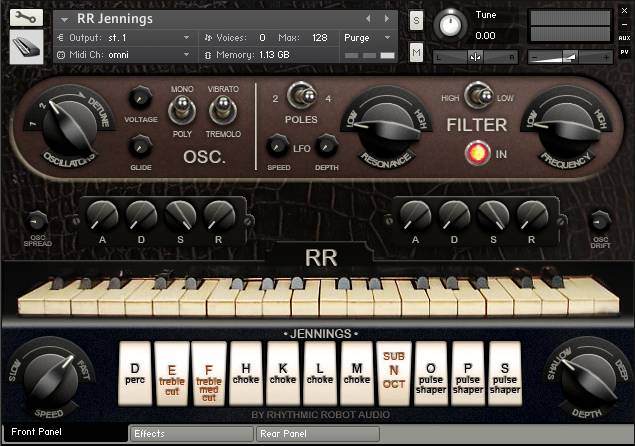 Once the samples were on our hard drive, the first thing we did was to make the monophonic Univox fully polyphonic. That was a no-brainer. You can switch to mono, of course, for basses and leads; but when played polyphonically Jennings really comes into its own, since every note brings its own inherent instabilities and variations to the sound – instabilities and variations which you can enhance using the “Osc Drift” control if you wish.
Once the samples were on our hard drive, the first thing we did was to make the monophonic Univox fully polyphonic. That was a no-brainer. You can switch to mono, of course, for basses and leads; but when played polyphonically Jennings really comes into its own, since every note brings its own inherent instabilities and variations to the sound – instabilities and variations which you can enhance using the “Osc Drift” control if you wish.
We also doubled up the number of oscillators. Switching the OSC panel’s big chicken-head knob from 1 to 2 kicks in a second sample set in unison with the first, thickening and warming the sound hugely. (These aren’t simply the same samples duplicated, but different samples, so there’s no sterile chorusing or phase cancellation; instead you get the real deal of feisty analogue goodness!) Twisting the knob further detunes the two oscillators progressively, while the “Osc Spread” control further down pans them for subtle or extreme stereo widening. Full envelope control, a glide amount knob for portamento, inbuilt saturation to introduce extra valve distortion, and the option of Tremolo instead of Vibrato round out the OSC section.
The FILTER offers high- or low-pass, 12dB/octave or 24dB/octave resonant filters with envelope control and a dedicated LFO routed to cutoff. This section massively expands the palette of tones you can source from Jennings: just dial up a good raw tone using the front tabs and then filter it and shape it just like in any conventional subtractive synth. Add some effects from the Effects pane, and a whole world of glorious valve-infused sound is within easy reach. Used in this way Jennings works and feels like a familiar subtractive synth, with the vital difference that instead of selecting a sawtooth or square wave to start with, you select a tab combination. Most analogue synthesisers offer only a handful of starting oscillator waveforms – maybe 3, 4 or 5 if you’re lucky. Jennings offers you over 2000 – and every single one of those waves has as its root DNA genuine valve tones from over seventy years ago.
Rounding out the sound-sculpting possibilities we have five effects processing blocks, accessible on the Effects pane. Chorus, Phaser, Delay, a Rotary Speaker control, and an amp cabinet simulator, can all shape Jennings’s sound either subtly or radically.
Finally, on the Rear pane, there are some extra tweakable settings: Stereo widening pans low notes left and high notes right, and works particularly well in combination with the Front Panel’s “Osc Spread” control. The Vibrato and Tremolo controls can have their ramp time varied here; the Oscillator envelope attack can also be adjust (for “snappy” or “sucky” attack portions), and there are level trim pots for tabs D (percussive attack) and N (Sub Osc) to allow you to blend these to your taste. (For example, in the real Univox, Sub Osc comes on VERY LOUD and there’s not much you can do about it! In Jennings, you can either go this route, which is great for bass patches; or you can back the Sub Osc trim off and use it to gently fill out a pad or texture patch, or even add some subtle body to a lead.)
Very importantly, this is also where you find the “Mod Wheel Controls Volume” toggle switch. With this active, you can use the modulation wheel on your controller keyboard to simulate the Univox’s knee lever and create expressive fades, swells, wobbles and jumps as you play. It’s a central component of the authentic Jennings tone, and works particularly well for pads and leads.
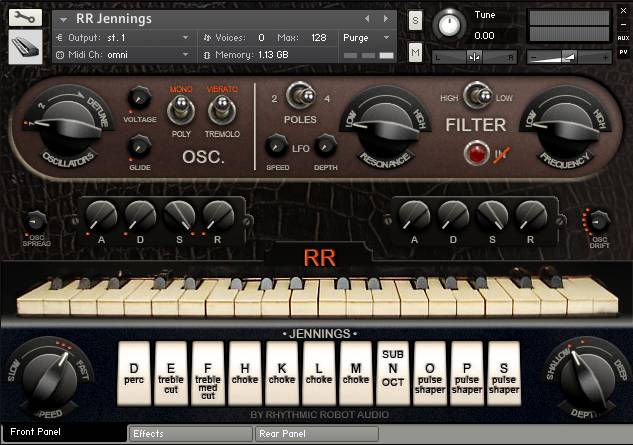 Of course, part of the fun of owning a synth like Jennings is not using all the wonderful effects and filters we’ve added, but going back to grass roots and treating the software as if it’s the real hardware: creating the same tones that George Harrison or John Lennon might have dialled up back in the Cavern. To make this process as transparent as possible, we’ve included a kind of “authenticity compliance mode” in Jennings. Simply click on the Rhythmic Robot “RR” logo just above the keyboard, and a host of little red dots and markers will spring up. These indicate which controls should be switched off (e.g., the FILTER section, the Effects, and so on), and, for controls that are in use, where to set them (e.g. the Vibrato Speed can be set to any of the three positions shown; its Depth to either of the two positions shown). By following this trail of breadcrumbs you can set Jennings up to be entirely 1946-authentic, and then use the tab switches to create synth tones that would sound identical to those coming from a real Jennings Univox.
Of course, part of the fun of owning a synth like Jennings is not using all the wonderful effects and filters we’ve added, but going back to grass roots and treating the software as if it’s the real hardware: creating the same tones that George Harrison or John Lennon might have dialled up back in the Cavern. To make this process as transparent as possible, we’ve included a kind of “authenticity compliance mode” in Jennings. Simply click on the Rhythmic Robot “RR” logo just above the keyboard, and a host of little red dots and markers will spring up. These indicate which controls should be switched off (e.g., the FILTER section, the Effects, and so on), and, for controls that are in use, where to set them (e.g. the Vibrato Speed can be set to any of the three positions shown; its Depth to either of the two positions shown). By following this trail of breadcrumbs you can set Jennings up to be entirely 1946-authentic, and then use the tab switches to create synth tones that would sound identical to those coming from a real Jennings Univox.
So, whether you want authentic tones from the early days of synth history, or brand-new creations that still have that warmth and glow to them, Jennings delivers. Cutting edge sampling and convolution techniques bring valves from seventy years ago back to life and put them right there in your DAW, ready to bathe everything in an amber glow (and a faint smell of warm crocodile skin). This is what synthesisers sounded like back at the dawn of an era. And you know what? They sounded good.
(All our Kontakt instruments require a full copy of Native Instruments Kontakt v4.2.3 or higher (including all versions of Kontakt 5). Kontakt Player is not supported: instruments will load, but will time out after 15 minutes. You can read a bit more about the history of the original Jennings Univox valve synth here.
It’s a triumph of virtualisation… Jennings has been beautifully realised and sounds gorgeous – weird, warm and characterful
Computer Music magazine
Jennings sounds like nothing else we’ve encountered… it excels at exceptional string and organ sounds. Producers looking for unique valve synthesiser sounds from a long-gone era should love it… In a market full of generic-sounding soft synths, Jennings recreates a unique flavour from a bygone era.
Future Music magazine
It’s dirtier than some of the other sounds on the market, and really feels like you’re playing an old instrument. The bass patches have a powerful raw feel about them, and could really give your tracks a dirtier edge in the low frequencies!
Film & Game Composers review
Finding a working Univox these days is rare. So when Rhythmic Robot got their hands on one, preserving it in Kontakt form became a bit of a quest… Jennings looks great and sounds authentic.
Sound on Sound Magazine
Rhythmic Robot build their instruments for experimentation, and Jennings includes sound design facilities that exceed the limitations of the original instrument in many ways.
Future Music magazine review
One thing that I instantly LOVED about the synth is the RR button… this disables any controls that are not original features of the machine. If you’re looking for that original Jennings sound then it’s available at the press of a button.
Film & Game Composers review
You must be logged in to post a review.
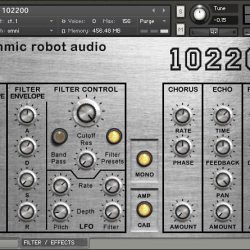
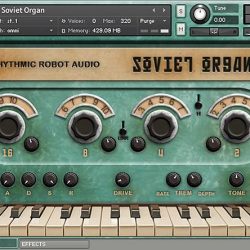
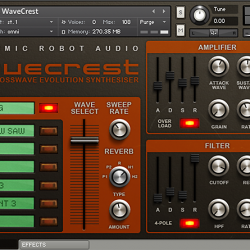
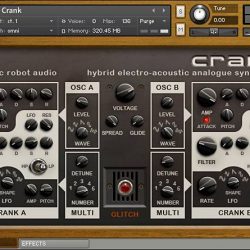
Reviews
There are no reviews yet.